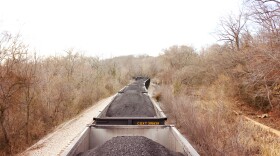According to research coordinated by a pair of Roanoke College professors, fossils common to coal seams may be responsible for dragon tales all around the world.
Three years ago, Dorothybelle Poli saw a dragon. She was part of a team collecting fossils for the Virginia Museum of Natural History in a quarry in West Virginia.
“I looked up, saw what looked like a partially covered dragon in the rock and said, ‘Hey, does everybody see the dragon?’ kind of like you see puppies in a cloud.”
What she saw was an ancient tree trunk, a fossil of a plant that, three hundred million years ago, grew one hundred feet tall and twenty feet across.
“And the pattern on that trunk is this gorgeous scale pattern that looks very serpent-like, very reptilian. If you see smaller branches, they look like legs. They look like tails. They look like neck structures. When a branch of this plant fell off, it leaves a three-dimensional structure that looks very much like an eye. And you could see them. The root structure of this organism also has something that looks very talon-like.”
These scaly, taloned fossils can be found anywhere there’s coal.
“These plants are basically your coal seam, along with some others. When you find this seam you can’t help but find them, which again would suggest that anybody around the world, if they found that dark layer, they were going to find their dragons.”
Near those dragons they might find the modern version of the plant, lycopodium.
“Lycopodium is about six to eight inches tall. It’s tiny. It’s an understory plant that most people ignore. But in Appalachia, specifically, this plant was used to make wreaths. The powder from the spores was used as poor man’s talcum powder. This is all very exciting because that same poor man’s talcum powder, if you ignite it, blows up.”
That explosiveness is something the modern plant seems to have in common with its ancient ancestor.
“The spores have not changed, evolutionarily. The plants have shrunk in size, but their spores don’t appear to have changed. Also, the fact that these plants blow up and they tend to grow in areas that are dark or near caves again, would suggest if you found this giant fossil and the modern plant was somewhere nearby, you could start linking that concept.”
All that interested Lisa Stoneman, a folklorist who teaches at Roanoke College.
“She wanted to know more about the dragons. I said, ‘Dragons aren’t real and I’m a scientist and that’s a real issue.’ And her response was, ‘I don’t care. Tell me more about these dragons.’”
Stoneman’s excitement overcame Poli’s trepidation.
“I wasn’t that concerned about people thinking it was a joke or that it was weird to deal with magic and folklore. She’s like, ‘This is really cool, but I don’t know if it’s going to be well received by the scientific community.’ So we decided to build our own community.”
For the past two years, Poli and Stoneman have coordinated the Dragon Research Collaborative, a project that found dragon stories do seem to originate near these fossils. Their students have produced books, paintings and sculpture. One documented commerce in dragon parts.
“Believe it or not, there were really trade routes for dragon products – dragon’s blood, dragon’s teeth. And he found primary documents related to that. So ended up tracking those dragon products over six hundred years.”
That’s an example of how students have driven the project, according to Poli and Stoneman. And the students have taken the DRC in interesting directions.
“The students have picked things that at first to us seem maybe a little off in the distance. But what they really wind up doing is tying our whole hypothesis together, so that’s been very exciting.”
“We keep directing a little bit and we ask questions and we feel like we’re more facilitators, I think, than teachers at this point. But I think those are the same things, so I like that.”
“We really want to educate people on how science and culture can interact and the power in that and the beauty in multidisciplinary questions.”
An exhibit of some of the products of the DRC’s research will be at the Wilson Hughes Art Gallery in Roanoke every Friday and Saturday through August 1.





